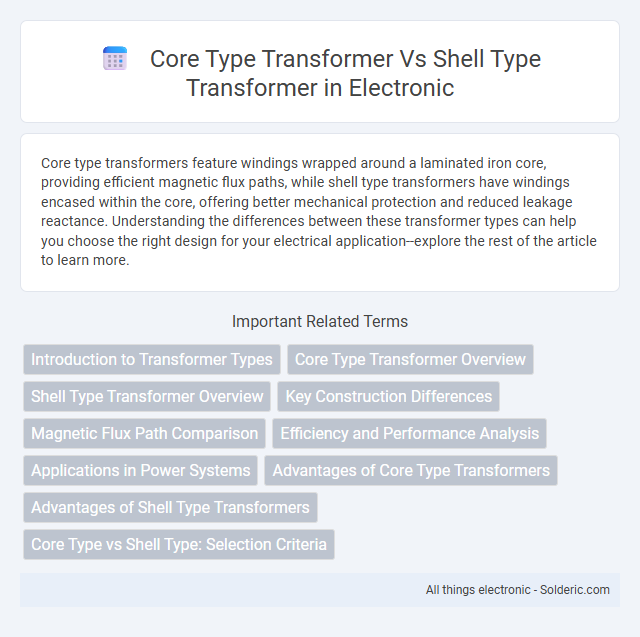Core type transformers feature windings wrapped around a laminated iron core, providing efficient magnetic flux paths, while shell type transformers have windings encased within the core, offering better mechanical protection and reduced leakage reactance. Understanding the differences between these transformer types can help you choose the right design for your electrical application--explore the rest of the article to learn more.
Comparison Table
| Feature | Core Type Transformer | Shell Type Transformer |
|---|---|---|
| Core Structure | Central magnetic core surrounded by windings | Windings encloses the magnetic core |
| Magnetic Flux Path | Flux passes through the core inside the windings | Flux passes through the shell around the windings |
| Mechanical Strength | Lower mechanical strength | Higher mechanical strength, better protection |
| Cooling | More effective cooling due to simpler design | Cooling less effective, complex design |
| Size and Weight | Generally lighter and smaller | Bulkier and heavier |
| Applications | Power distribution, general purpose | High power industrial use, high voltage applications |
| Cost | Generally lower cost | Higher manufacturing cost |
Introduction to Transformer Types
Core type transformers feature a magnetic core with coils wrapped around separate limbs, allowing efficient magnetic flux distribution and ease of maintenance. Shell type transformers have coils encased by the magnetic core, providing better short-circuit strength and reduced leakage reactance. Your choice between core type and shell type transformers depends on application requirements such as performance, durability, and space constraints.
Core Type Transformer Overview
Core type transformers feature a central magnetic core with windings wrapped around it, enabling efficient magnetic flux circulation and reduced leakage inductance. Their construction allows for easier cooling and maintenance due to exposed windings, making them suitable for low-voltage applications. The design emphasizes magnetic path efficiency, optimizing core material usage and minimizing losses in power distribution systems.
Shell Type Transformer Overview
Shell type transformers feature a core that surrounds the windings, providing enhanced mechanical protection and better magnetic flux containment. This design improves efficiency by minimizing leakage flux and reducing noise levels, making it ideal for high-voltage and precision applications. The layered core structure also offers superior thermal performance and fault tolerance compared to core type transformers.
Key Construction Differences
Core type transformers feature a magnetic core with windings wrapped around individual limbs, providing easier maintenance and better heat dissipation, whereas shell type transformers have windings surrounded by a magnetic core, offering enhanced mechanical protection and compact design. Core type transformers typically have a rectangular or square core with windings on two or more limbs, while shell type transformers use a core with multiple limbs that encase the windings on the central limb. The structural difference influences insulation requirements and fault tolerance, with shell type designs generally providing superior short-circuit strength due to the enclosing core.
Magnetic Flux Path Comparison
The magnetic flux path in a core type transformer flows through a rectangular core with coils placed around two opposite limbs, creating a mostly linear and straightforward flux circulation. In shell type transformers, the flux path is more complex, as it involves the magnetic flux traveling through a central limb encased by the coil and two outer limbs, providing multiple parallel flux paths and better magnetic circuit closure. This design in shell type transformers reduces leakage flux and magnetic losses, enhancing efficiency compared to the core type.
Efficiency and Performance Analysis
Core type transformers generally exhibit higher efficiency due to their simpler magnetic circuit design, which minimizes core losses and improves energy transfer. Shell type transformers provide better mechanical protection and reduced leakage reactance, enhancing performance in applications requiring compactness and higher short-circuit strength. Your choice depends on whether you prioritize energy efficiency or mechanical robustness for the specific electrical load and installation environment.
Applications in Power Systems
Core type transformers are widely used in power generation plants and industrial applications due to their superior mechanical strength and ease of maintenance, making them suitable for high voltage and heavy current loads. Shell type transformers find extensive use in distribution networks and low voltage applications where better short-circuit protection and compact design are essential. Both types play critical roles in power systems, with core type preferred for efficiency in bulk power transmission and shell type favored for localized electrical distribution.
Advantages of Core Type Transformers
Core type transformers offer superior mechanical strength and easier cooling due to their rectangular core design, which efficiently dissipates heat. Their construction allows for simpler winding arrangements, reducing manufacturing complexity and cost. These transformers typically exhibit lower leakage reactance, enhancing voltage regulation and performance in power distribution systems.
Advantages of Shell Type Transformers
Shell type transformers provide superior mechanical strength and better short-circuit resistance due to their encapsulated design, which effectively minimizes flux leakage and improves magnetic circuit efficiency. They offer reduced noise levels and enhanced thermal performance since the core surrounds the windings, promoting efficient heat dissipation. Your equipment benefits from greater durability and reliability in demanding industrial environments with shell type transformers compared to core type variants.
Core Type vs Shell Type: Selection Criteria
Core type transformers feature windings surrounding a rectangular laminated core, offering easier cooling and simpler construction, making them suitable for high-voltage applications. Shell type transformers have windings enclosed by a core with multiple limbs, providing better mechanical protection and reduced leakage flux, ideal for applications requiring high short-circuit strength and compact design. Selection criteria hinge on voltage levels, cooling requirements, mechanical durability, and spatial constraints, with core type favored for efficiency and shell type for robustness and fault tolerance.
core type transformer vs shell type transformer Infographic

 solderic.com
solderic.com